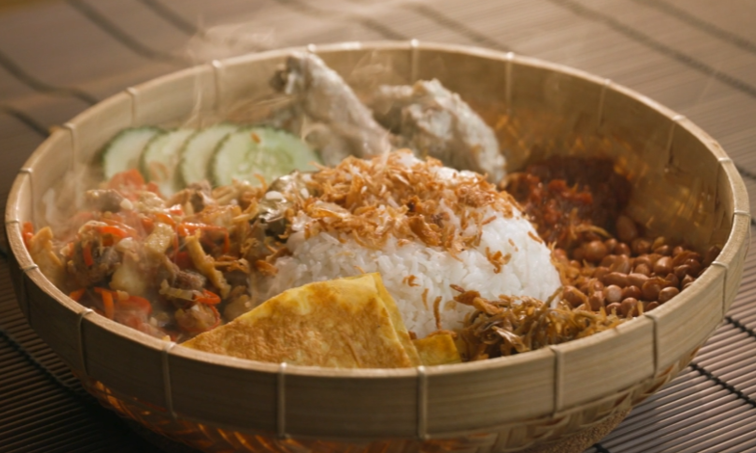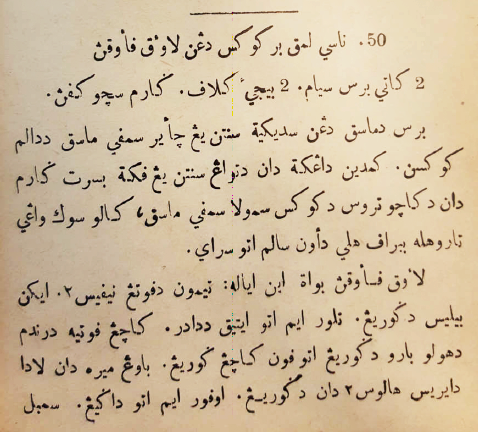Nasi Lemak Istimewa
Is it heresy to make nasi lemak with bay leaves instead of pandan? Join librarian Toffa Abdul Wahed to find out.
Episode summary
In this episode, we make an unusual version of nasi lemak using a recipe from 1953. The recipe comes from a book by Siti Radhiah, a Malay cookbook author who was also the wife of writer Harun Aminurrashid. Is it really nasi lemak if it doesn’t use pandan? Join librarian and food researcher Toffa Abdul Wahed as she makes this unique nasi lemak and two side dishes.

Recipes
Toffa made Siti Radhiah’s recipes of nasi lemak berkukus dengan lauk-pauknya (steamed nasi lemak and its accompaniments), which were originally published in her third cookbook, Memilih Selera in Jawi in 1953. Malay publications were predominantly published in Jawi until the late 1950s. In 1961, Siti Radhiah’s second cookbook, Hidangan Wanita Sekarang, was published in romanised Malay to reach a wider audience.
True to Siti Radhiah’s spirit of spreading knowledge, Toffa has translated the recipes into English. Recipes of that time tend to be brief and leave out measurements. Toffa has added her detailed notes below.

Nasi lemak berkukus
2 kati (~1210 g) Thai rice
2 coconuts
salt (In the video, Toffa used ¾ tsp. of salt for 300 g of rice.)
Siti Radhiah's instructions
Cook rice with thin coconut milk in a steamer. Then remove it and pour in salted thick coconut milk and stir. Steam again until cooked. If you like it fragrant, add a few bay leaves or lemongrass.
Its accompaniments are thinly sliced cucumber, fried anchovies, and omelettes made from chicken eggs or duck eggs. Kacang putih is soaked first and then fried. Slice red onions and chillies thinly, and fry them. Nasi lemak can also go with opor ayam (chicken cooked in coconut milk) and sambal goreng.
Toffa's notes
Extracting the coconut milk (for 300 g of rice)
- First extraction (thick coconut milk): add 300 ml of warm water to the grated coconut.
Massage the grated coconut with water before squeezing. Use a coconut bag or squeeze it over a strainer or sieve. The extraction will yield more than 300 ml, as the coconut has moisture in it. After squeezing, set aside 150 ml for the nasi lemak. The rest will go into the opor ayam. - Second extraction (thin coconut milk): add 300 ml of warm water to the grated coconut.
Set aside 150 ml for the nasi lemak. The rest will go into the opor ayam. - Third extraction (thin coconut milk): add 300 ml of warm water to the grated coconut.
The extraction is for the nasi lemak. Do not discard the coconut, in case more coconut milk is needed later.
Making nasi lemak berkukus (using 300 g of rice)
- Heat the steamer.
- Place the rice into the steaming tray.
- Add the thin coconut milk from the second and third squeezes.
- Add bay leaves, pandan or lemongrass. Remove a bit of the stalk to release aroma, so that it is better infused with the rice.
- Steam for 15 minutes.
- After 15 minutes, if there is still a lot of coconut milk, stir the rice mixture and steam for another 15 minutes.
- When most of the coconut milk has been absorbed, gently stir the rice and add the thick coconut milk (150 ml). Salt the coconut milk. Steam for another 15 minutes.
- At each step, taste the rice to check for doneness, and gently stir the rice, so that it cooks evenly.
- If the rice is not completely cooked, stir and continue steaming for another 10 minutes.
- When the rice is cooked, turn off the heat and allow the rice to rest in the steamer for at least 10 minutes. Then fluff the rice with a fork or spoon. Caution: Steam is very hot. Do not get burned by it. Use a long ladle to stir the rice, or wear an oven mitten.
Opor ayam
1 chicken
½ tbsp. coriander seeds
½ tsp. white pepper
a pinch of salt
3 cloves garlic
10 red onions
10 candlenuts
a thumb-sized piece of ginger
a bit of galangal (Toffa: ½ thumb of galangal)
1 coconut
3 bay leaves
some lemongrass (Toffa: 2 stalks of lemongrass)
Toffa: 10 shallots, thinly sliced
Siti Radhiah's instructions
Ground coriander seeds, salt and white pepper together. Then add garlic, candlenuts, galangal, ginger and red onions. Grind them until fine. Sauté all of the spices with a bit of coconut oil. Then add bay leaves, lemongrass and chicken that has been cleaned and chopped up, and stir. When most of the liquid has dried up, add coconut milk. When the gravy is thick and the chicken is tender, remove from heat.
Toffa's notes
The opor ayam can be cooked while the rice is being steamed.
- Pound, grind or blend coriander seeds and white peppercorns. Then add garlic, candlenuts, galangal, ginger and shallots. With a blender, use coriander powder and white pepper powder instead of the seeds and corns, as they might be too small for the blender blades. Pound, grind or blend until you get a fine paste.
- Heat the coconut oil in a pot at low-medium heat. Do not use high heat, as coconut oil has a low smoking point.
- Add the rempah or spice paste. Sauté until it becomes fragrant and the paste is no longer raw. Do not burn or overcook it.
- Add bay leaves and lemongrass. Break the lemongrass with the pestle or a hard object before adding it in.
- Add the chicken and fry it for a while in the spices.
- Add the thick and thin coconut milk that has been set aside for the opor ayam.
- Salt to taste.
- Cover the pot. Stir occasionally and continue cooking at low-medium heat.
- Once the chicken is cooked, remove the lid and continue cooking to reduce and thicken the gravy.
- The thickness of the sauce is up to your own liking. Salt to taste.
Sambal goreng
½ kati (~303 g) meat
4 tbsp. sliced red onions
4 slices ginger
a bit of sliced lemongrass (Toffa: 1 stalk of lemongrass)
4 cloves garlic, sliced
½ tsp. belacan (fermented shrimp paste)
a bit of granulated sugar
15 red chillies, thinly sliced. Dried chillies can also be used. (Toffa: Deseed a few of the chillies, depending on how spicy you want the dish to be.)
4 firm tofu, sliced
salt
a bit of tamarind
Siti Radhiah's instructions
Clean the meat well, cut it into small pieces, and fry them. Sauté red onions, garlic, ginger and lemongrass in cooking oil. Then add the thinly sliced dried chillies and stir. Add the fried meat and cut the tofu, followed by shrimp paste, and a bit of salt, sugar and tamarind juice. If you like, add some pati santan (undiluted thick coconut milk). Stir until dry, and remove from heat. Sambal goreng is also made with tempeh and thinly sliced long beans.
Toffa's notes
- Fry the beef and remove from pan, preferably a non-stick pan.
- Fry the tofu and remove from pan.
- Remove some oil from the pan. Leave enough oil to cook the rest of the dish and assemble all the ingredients.
- Fry shallots, garlic, ginger and lemongrass until fragrant, the shallots are cooked or turn translucent, and the garlic turn slightly golden.
- Add the red chillies and fry briefly until they wilt or slightly soften.
- Add the beef and tofu.
- In a small bowl, add belacan and tamarind paste. Add water to dissolve the belacan and mix in the tamarind paste.
- Pour mixture into the pan. Ensure enough liquid to coat the beef and tofu. This allows for the belacan and tamarind mixture to be absorbed by the beef and tofu. If it is too dry, it will be harder for the beef and tofu to absorb the seasoning. Extra water can always be cooked down.
- Add salt and sugar to taste while there is still liquid in the pan. Note: Not too much salt since the belacan is already salty.
- The final dish should have little to no gravy.

Related Articles
Siti Radhiah’s Cookbooks for the Modern Malay Woman
A number of cookbooks written in the 1940s and 1950s helped expand the traditional Malay culinary repertoire, as Toffa Abdul Wahed tells us.
Early Malay Printing in Singapore
Mazelan Anuar tracks the rise and decline of Malay printing and publishing in 19th-century Singapore, and profiles two of the most prolific printers of that period.
Nasi Lemak
Nasi lemak is a dish made from rice cooked in coconut milk. Aromatics, such as pandan leaves, lemongrass, ginger, garlic and fenugreek, can be added to it.
Sharing Knowledge about Cookery
Today, cookbooks regularly top bestsellers’ lists and make great presents for friends and loved ones. But what were cookbooks like half a century ago? Associate Librarian Toffa takes a (tasty) trip down memory lane to find out.
Related Books
Siti Radhiah Mohamed Saleh, Memilih Selera [Choosing tastes] (Singapore: Harmy, 1953).
Khir Johari, The Food of Singapore Malays: Gastronomic Travels through the Archipelago (Singapore: Marshall Cavendish Editions, 2021).
Rita Zahara, The Many Flavours of Malay Cooking (Singapore: Marshall Cavendish Cuisine, 2016).

